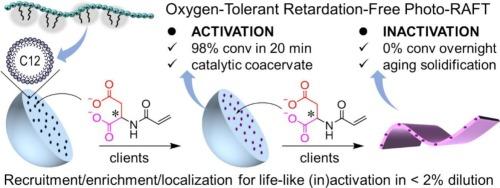Self-adaptable activation and inactivation of RAFT polymerization: a liquid-liquid phase separation scaffold-client platform
IF 6.3
2区 化学
Q1 POLYMER SCIENCE
引用次数: 0
Abstract
Complex coacervates provide a powerful platform to explore life-like reaction functions. However, the droplet compartmentalization and compartment-specific viscoelasticity control for reaction (in)activation toward life-like functionality and adaptivity are of great challenge. Herein, we present a liquid–liquid phase separation (LLPS) scaffold-client platform for self-adaptable reaction (in)activation under aqueous RAFT conditions in dilution in the presence of air. Self-assembly of dodecyl-containing amphiphilic cationic polyelectrolyte (C12-Polyelectrolyte) leads to the droplet scaffold with compartmentalization into densely-charged C12-rich dense-phase compartments and NHR3+-rich dilute-phase compartments, showing extremely high salt-resistance up to 4.5 M NaCl via “salting-out” driven droplet shrinkage. Precise recruitment of anionic aspartic acid acrylamide monomer (clients) into dense-phase compartments maintaining liquid dilute-phase compartments, leads to the catalytic coacervates that can activate ultrafast oxygen-tolerant retardation-free photo-RAFT polymerization in < 2 % w/w monomer dilution (98 % conversion in 20 min). Nevertheless, excess monomer recruitment to dilute-phase compartments leads to droplet hardening and droplet-to-lamella transition, resulting in reaction inactivation involving kinetically-trapped retardation and kinetically-frozen inhibition (overnight reaction: 0 % conversion). This self-adaptable reaction (in)activation highlights pivotal roles of droplet compartmentalization and compartment-specific viscoelasticity control in life-like reaction functions, and provides simple guidelines for rational design of catalytic coacervate nanoreactors toward life-like functionality and adaptivity.

RAFT聚合的自适应活化与失活:一种液-液相分离支架-客户端平台
复杂凝聚体为探索类生命反应函数提供了一个强大的平台。然而,液滴的区隔化和区隔特异性粘弹性控制对反应激活的生活化和适应性是一个巨大的挑战。在此,我们提出了一种液-液相分离(LLPS)支架-客户端平台,用于在空气存在的稀释条件下在水RAFT条件下自适应反应(in)激活。含十二烷基的两亲性阳离子聚电解质(C12-Polyelectrolyte)的自组装使得液滴支架区隔化为富含c12的致密相区隔和富含NHR3+的稀相区隔,通过“盐析”驱动的液滴收缩表现出极高的耐盐性,最高可达4.5 M NaCl。阴离子天冬氨酸丙烯酰胺单体(客户端)被精确地招募到浓相隔间中,保持液体稀相隔间,导致催化凝聚,可以在2% w/w的单体稀释下(20分钟内转化率为98%)激活超快的耐氧无延迟光- raft聚合。然而,过量的单体聚集到稀相区室导致液滴硬化和液滴向片层转变,导致反应失活,包括动力学捕获阻滞和动力学冻结抑制(隔夜反应:0%转化)。这种自适应反应激活强调了液滴区隔化和区隔特异性粘弹性控制在类生命反应功能中的关键作用,并为合理设计催化凝聚纳米反应器以实现类生命功能和适应性提供了简单的指导。
本文章由计算机程序翻译,如有差异,请以英文原文为准。
求助全文
约1分钟内获得全文
求助全文
来源期刊

European Polymer Journal
化学-高分子科学
CiteScore
9.90
自引率
10.00%
发文量
691
审稿时长
23 days
期刊介绍:
European Polymer Journal is dedicated to publishing work on fundamental and applied polymer chemistry and macromolecular materials. The journal covers all aspects of polymer synthesis, including polymerization mechanisms and chemical functional transformations, with a focus on novel polymers and the relationships between molecular structure and polymer properties. In addition, we welcome submissions on bio-based or renewable polymers, stimuli-responsive systems and polymer bio-hybrids. European Polymer Journal also publishes research on the biomedical application of polymers, including drug delivery and regenerative medicine. The main scope is covered but not limited to the following core research areas:
Polymer synthesis and functionalization
• Novel synthetic routes for polymerization, functional modification, controlled/living polymerization and precision polymers.
Stimuli-responsive polymers
• Including shape memory and self-healing polymers.
Supramolecular polymers and self-assembly
• Molecular recognition and higher order polymer structures.
Renewable and sustainable polymers
• Bio-based, biodegradable and anti-microbial polymers and polymeric bio-nanocomposites.
Polymers at interfaces and surfaces
• Chemistry and engineering of surfaces with biological relevance, including patterning, antifouling polymers and polymers for membrane applications.
Biomedical applications and nanomedicine
• Polymers for regenerative medicine, drug delivery molecular release and gene therapy
The scope of European Polymer Journal no longer includes Polymer Physics.
 求助内容:
求助内容: 应助结果提醒方式:
应助结果提醒方式:


